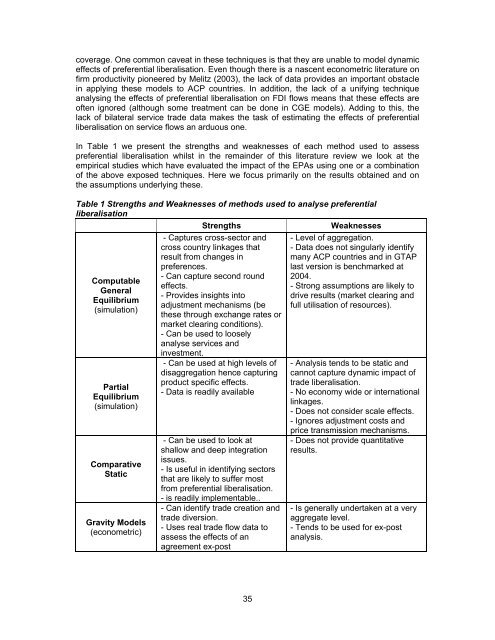EPA Review Annex Documents - DFID
EPA Review Annex Documents - DFID
EPA Review Annex Documents - DFID
You also want an ePaper? Increase the reach of your titles
YUMPU automatically turns print PDFs into web optimized ePapers that Google loves.
coverage. One common caveat in these techniques is that they are unable to model dynamic<br />
effects of preferential liberalisation. Even though there is a nascent econometric literature on<br />
firm productivity pioneered by Melitz (2003), the lack of data provides an important obstacle<br />
in applying these models to ACP countries. In addition, the lack of a unifying technique<br />
analysing the effects of preferential liberalisation on FDI flows means that these effects are<br />
often ignored (although some treatment can be done in CGE models). Adding to this, the<br />
lack of bilateral service trade data makes the task of estimating the effects of preferential<br />
liberalisation on service flows an arduous one.<br />
In Table 1 we present the strengths and weaknesses of each method used to assess<br />
preferential liberalisation whilst in the remainder of this literature review we look at the<br />
empirical studies which have evaluated the impact of the <strong>EPA</strong>s using one or a combination<br />
of the above exposed techniques. Here we focus primarily on the results obtained and on<br />
the assumptions underlying these.<br />
Table 1 Strengths and Weaknesses of methods used to analyse preferential<br />
liberalisation<br />
Strengths Weaknesses<br />
Computable<br />
General<br />
Equilibrium<br />
(simulation)<br />
Partial<br />
Equilibrium<br />
(simulation)<br />
Comparative<br />
Static<br />
Gravity Models<br />
(econometric)<br />
- Captures cross-sector and<br />
cross country linkages that<br />
result from changes in<br />
preferences.<br />
- Can capture second round<br />
effects.<br />
- Provides insights into<br />
adjustment mechanisms (be<br />
these through exchange rates or<br />
market clearing conditions).<br />
- Can be used to loosely<br />
analyse services and<br />
investment.<br />
- Can be used at high levels of<br />
disaggregation hence capturing<br />
product specific effects.<br />
- Data is readily available<br />
- Can be used to look at<br />
shallow and deep integration<br />
issues.<br />
- Is useful in identifying sectors<br />
that are likely to suffer most<br />
from preferential liberalisation.<br />
- is readily implementable..<br />
- Can identify trade creation and<br />
trade diversion.<br />
- Uses real trade flow data to<br />
assess the effects of an<br />
agreement ex-post<br />
35<br />
- Level of aggregation.<br />
- Data does not singularly identify<br />
many ACP countries and in GTAP<br />
last version is benchmarked at<br />
2004.<br />
- Strong assumptions are likely to<br />
drive results (market clearing and<br />
full utilisation of resources).<br />
- Analysis tends to be static and<br />
cannot capture dynamic impact of<br />
trade liberalisation.<br />
- No economy wide or international<br />
linkages.<br />
- Does not consider scale effects.<br />
- Ignores adjustment costs and<br />
price transmission mechanisms.<br />
- Does not provide quantitative<br />
results.<br />
- Is generally undertaken at a very<br />
aggregate level.<br />
- Tends to be used for ex-post<br />
analysis.
















